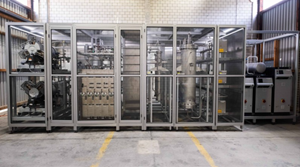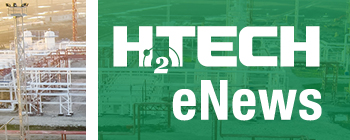News
Empa’s new plant produces methane from renewable H2 and CO2
Empa’s new methanation plant, move-MEGA, brings together central components of the energy transition: It produces methane from renewable H2 and CO2, with a deliberate focus on increasing the load flexibility of the process – a crucial advantage for utilizing fluctuating renewable electricity sources. The innovative demonstration plant shows how renewable solar power can be converted directly into H2 via electrolysis and then, together with CO₂ captured from ambient air, processed into synthetic methane – ready to be fed into the gas grid. The direct integration of these processes at a single site is unique.
At the heart of the new plant is a process termed sorption-enhanced methanation, where zeolite pellets with defined pore sizes serve as catalyst carrier. These pellets adsorb the water produced as a byproduct during methanation, shifting the chemical equilibrium in favor of methane formation. As a result, the process can be operated at lower pressures and temperatures, and the methane produced can be used directly or injected into the gas grid without elaborate post-treatment.
A key aspect of developing this new process was thermal management: To ensure continuous operation, at least two reactors are required, alternating between methane production and regeneration/drying. For this drying step, a sophisticated thermal management is essential, allowing waste heat from methanation to be either removed from the reactor or stored in the catalyst bed. The Empa team led by Florian Kiefer and Andreas Borgschulte spent over five years developing this technology from fundamental research, through lab scale facilities to a functional demonstrator.
“Thanks to sorption-enhanced methanation and advanced thermal management, we achieve high conversion rates and significantly greater load flexibility than with conventional methods. This makes the technology especially attractive for direct coupling with photovoltaic or wind power plants,” explains move-MEGA project leader Florian Kiefer.
From synthetic methane to a CO₂ sink. The power-to-gas demonstrator also integrates a direct air capture (DAC) unit, enabling the CO₂ needed for methanation to be sourced directly from ambient air. This creates the precondition for negative CO₂ emissions: In a subsequent step, the methane can be split via methane pyrolysis into solid carbon and H2, as shown in current Empa research projects. Solid carbon then serves as a long-term CO₂ sink and can be used in building materials such as concrete or asphalt. H2 an be used as an energy carrier for industrial high-temperature applications that are currently dependent on fossil fuels and are difficult to electrify. A demonstration project is currently underway in collaboration with the Association for the Decarbonization of Industry (VzDI) in Zug.
“Methanation combined with methane pyrolysis opens a path to combine renewable energy supply with permanent removal of CO₂ from the atmosphere. This enables negative CO₂ emissions,” explained Christian Bach, initiator of the move-MEGA project and head of Empa's Chemical Energy Carriers and Vehicle Systems laboratory.
move-MEGA. With the inauguration of the demonstration plant, the move-MEGA-project, dedicated to producing synthetic methane from sustainable H2 and CO₂ from ambient air, was successfully completed. At its core is the sorption-enhanced methanation technology developed at Empa, used here for the first time in a demonstration facility within Empa’s mobility demonstrator move. Alongside sorption-enhanced methanation, special focus is placed on the efficient use of process waste heat, which is integrated into existing system components. The project was supported by the ETH Board, the Canton of Zurich, Glattwerk, Avenergy Suisse, Migros, Lidl Switzerland, Armasuisse and Swisspower.


